The Great Backyard Bird Count (GBBC) is an event that occurs every year over the President’s Day weekend in February. The main sponsors are the Cornell Lab, Audubon, Birds Canada, and Wild Birds Unlimited. In a nutshell, it’s a calling-all-birders thing where birders all over the world go out and count as many bird species as is humanly possible over the course of four days. It’s super geeky, if you ask me.
So, why do I even participate in this event? You all know I don’t keep a running “life list” except in my empty head. Whenever it’s that time of the month and we have the Backyard Bird Race, I shrug. But if you know me well, you know I’m a little competitive. Not super competitive in an annoying way, but just annoying enough to annoy my wife, which is the point. So, this GBBC gives me an outlet. Plus it’s an outdoor activity, it involves nature, and it’s a bit sciencee (data!).
To give my GBBC some limits and goals, I selected my county, Snohomish County, as my geographic boundary. The goal was to count more bird species than any other birder within my county. Let me tell you, there are some serious birders here in SnohoCo. You know the ones. They’re always posting their checklists on eBird. They’re always the ones to post the rare bird sightings, and then keep posting it as “continuing.” They’ve seen more bird species in your county than you’ll ever hope to see in your lifetime. You know the people I’m talking about, right? Nothing gives me more pleasure than to be the dark horse that shows up out of nowhere on the top counts. Who is this guy? It’s me, lol!
I formulated a loose plan of attack, subject to change, based on weather and personal obligations. Loosely, the plan was and turned out to be:
Day 1 — Friday: Edmonds - waterfront and the home patch
Day 2 — Saturday: The Seattle RV Show, a personal obligation to my wife
Day 3 — Sunday: Sprague’s Pond (Lynnwood), Ebey Waterfront Trail (Marysville), Norman Road (Silvana), and Leque Island (Stanwood)
Day 4 — Crescent Lake WMA (Monroe), Heirman Wildlife Preserve (Snohomish), Snohomish Wastewater Treatment Plant, and back to Edmonds to bat cleanup
Here were the top 10 hotspots for Snohomish County during the four-day GBBC. I hit four of them as highlighted.
The top hotspot, Tulalip Bay is access restricted along most of it’s shoreline to tribal members and residents. Boo. There is one serious birder who lives there along Tulalip Bay and is always reporting on eBird.
Here’s how it went down:
Day 1 — Edmonds
I spent the whole day along the Edmonds shoreline that included an expedition on foot into the Edmonds Marsh along some newly created trails. I bookended the day, morning and evening, with my home patch sightings. The weather was sunny with a slight chill in the air. The birding highlights were the large flocks of Brant resting on the offshore waters or flying to new eelgrass feeding grounds. A real thrill was spotting a Cooper’s Hawk at the Marsh. Conspicuously absent and not observed were House Finches and House Sparrows, two very common birds at the waterfront that I can always count on to add to my species number. I know exactly where they hang out, too. A total of nine checklists for the day.
Let’s look at Day 1 in photos.
 The Edmonds Fishing Pier and the Olympic Mountains
The Edmonds Fishing Pier and the Olympic Mountains
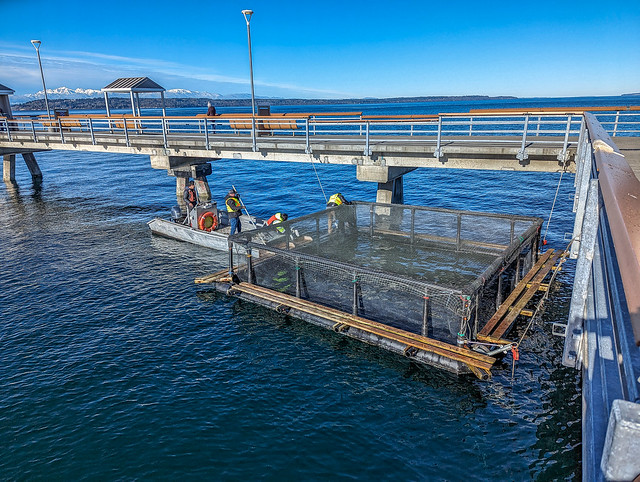 “About 30,000 coho salmon smolt from the Washington State Department of Fish and Wildlife’s Issaquah salmon hatchery were introduced to a net pen along the Edmonds waterfront Wednesday. It’s an annual event involving volunteers from the Puget Sound Anglers Association Sno-King Chapter.
The pen will be attached to cables anchored at the Edmonds Fishing Pier on Friday. Volunteers will feed pellets to the one-year-old smolts several times a week. After spending a few months in Edmonds waters for imprinting, the salmon will be released to mature. When it comes time to spawn, the hope is that the survivors will return to the Edmonds area to lay eggs or be caught by local fishermen.” myedmondsnews.com/...
“About 30,000 coho salmon smolt from the Washington State Department of Fish and Wildlife’s Issaquah salmon hatchery were introduced to a net pen along the Edmonds waterfront Wednesday. It’s an annual event involving volunteers from the Puget Sound Anglers Association Sno-King Chapter.
The pen will be attached to cables anchored at the Edmonds Fishing Pier on Friday. Volunteers will feed pellets to the one-year-old smolts several times a week. After spending a few months in Edmonds waters for imprinting, the salmon will be released to mature. When it comes time to spawn, the hope is that the survivors will return to the Edmonds area to lay eggs or be caught by local fishermen.” myedmondsnews.com/...
 Brant on the wing
Brant on the wing
 Glaucous-winged Gull tries to gulp down a sea star.
Glaucous-winged Gull tries to gulp down a sea star.
 Glaucous-winged Gull working on a red rock crab.
Glaucous-winged Gull working on a red rock crab.
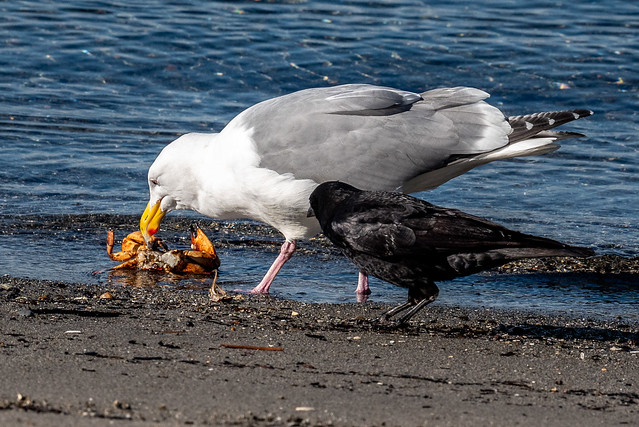 Crow waits for his chance
Crow waits for his chance
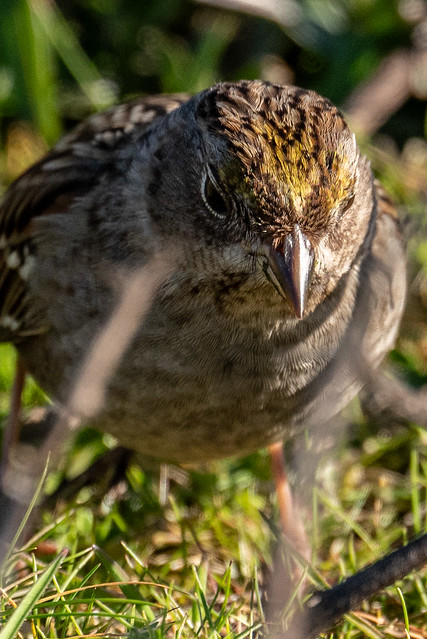 Golden-crowned Sparrow. If the day wasn’t bringing House Sparrows or House Finches, at least I was able to add this Golden-crowned Sparrow in the same location I’d seen them before. Familiarity with a place is helpful.
Golden-crowned Sparrow. If the day wasn’t bringing House Sparrows or House Finches, at least I was able to add this Golden-crowned Sparrow in the same location I’d seen them before. Familiarity with a place is helpful.
 Cooper’s Hawk at Edmonds Marsh, the day’s highlight. This looks like a juvenile.
Cooper’s Hawk at Edmonds Marsh, the day’s highlight. This looks like a juvenile.
 And just like that, it’s gone.
And just like that, it’s gone.
Day 2 — Seattle RV Show
I can’t complain about this day that I spent with my wife, eating good food, and ending up walking 12 miles all over Seattle. No RV, but fun to look at and people watch. We’ve just about concluded that for the price of an RV, we can buy a lot of nights in a hotel.
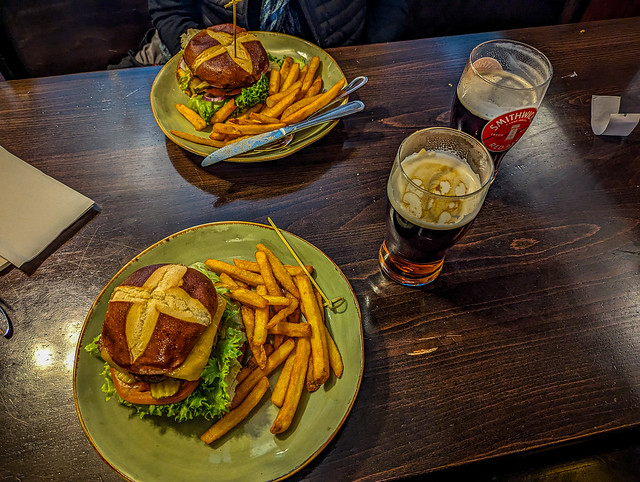 Burgers and beer at O’Donnell’s Irish Pub
Burgers and beer at O’Donnell’s Irish Pub
 Iconic
Iconic
Day 3 — Sprague’s Pond, Ebey Waterfront Trail, Norman Road, and Leque Island
This was without a doubt my best and most fun day of the GBBC, visiting my favorite hotspots. First stop was Sprague’s Pond, which is about three miles from home. The setting is suburbia, but this pond always delivers as indicated by it’s tenth position in the GBBC hotspot list. My goal was to spot a Hooded Merganser and a Pied-billed Grebe. And it delivered, thank you very much. Moving on.
Next up was the Ebey Waterfront Trail. The trail is a paved path that follows Ebey Slough for a couple miles and also passes the Marysville sewage ponds. The habitats the trail passes are varied: riverine, riparian, tidal estuary, marsh, shrubs, trees, plus the sewer ponds that were jam-packed with Lesser Scaups and Ring-necked Ducks, plus a few other ducks. I picked up 27 species on this walk. The highlight was spotting a Northern Shrike and a White-throated Sparrow (my new favorite sparrow, for now). There were a few Northern Harriers flying low. Some photo highlights:
 Lesser Scaup drake at the Marysville sewer ponds. The Lessers, as we know, have the little noogy on top of their heads.
Lesser Scaup drake at the Marysville sewer ponds. The Lessers, as we know, have the little noogy on top of their heads.
 Common Mergansers coming in hot on Ebey Slough
Common Mergansers coming in hot on Ebey Slough
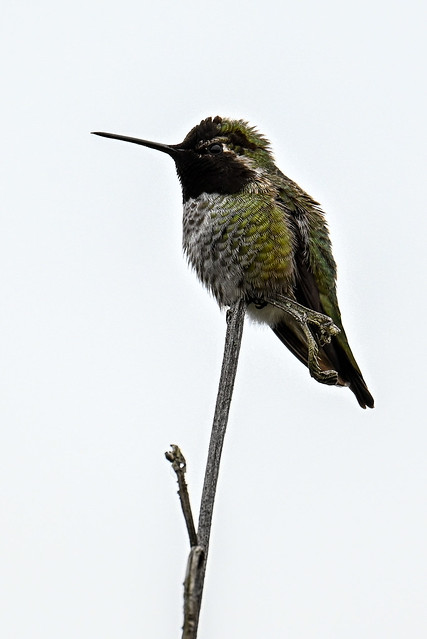 Male Anna’s Hummingbird. I wasn’t able to get a shot of the glowing red iridescent gorget. It’s a trick of the light.
Male Anna’s Hummingbird. I wasn’t able to get a shot of the glowing red iridescent gorget. It’s a trick of the light.
 Northern Shrike on barbed-wire, a perfect spot to impale its meals. This one looks like a juvenile.
Northern Shrike on barbed-wire, a perfect spot to impale its meals. This one looks like a juvenile.
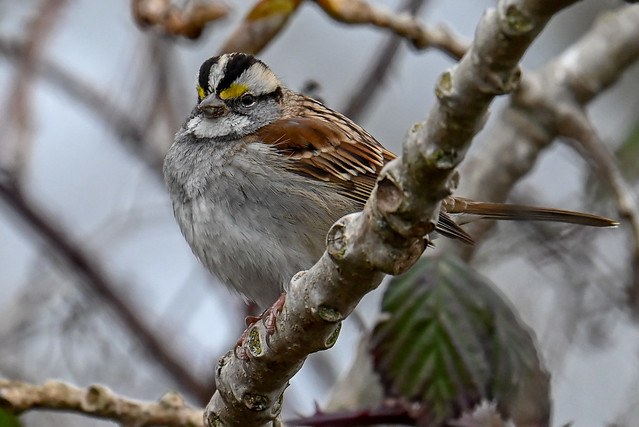 White-throated Sparrow in the shrubs and brambles. It gave me some good looks.
White-throated Sparrow in the shrubs and brambles. It gave me some good looks.
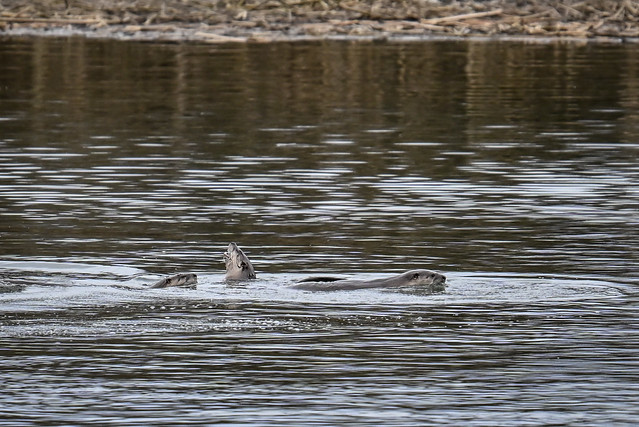 A family of river otters cruised by on the Slough.
A family of river otters cruised by on the Slough.
Next stop was a slow cruise along Norman Road through the Stilliguamish River Valley, home to dairy and beef farms, and a prime winter spot for swans. They were here, all Trumpeters as far as I could tell. There were also hundreds of American Wigeons out in the fields. There was a good chance of spotting a Eurasian Wigeon among the crowd, and I did. As I was slowly cruising along and stopping to look, a farmer came by in his truck and rolled down his window. So, we chatted for a long while. The human element is part of the fun and I enjoy an opportunity to interact with another human, especially one of the locals.
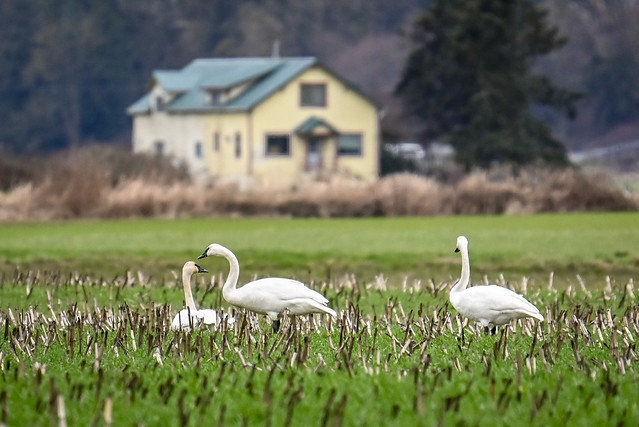 Trumpeter Swans along Norman Road.
Trumpeter Swans along Norman Road.
The last stop of Day 3 was Leque Island, where I was hoping to see some shorebirds, especially Dunlin. But, no Dunlin. There were hundreds of Green-winged Teal out on the mudflats. But no Eurasian Teals among them. There were people to chat with. A young couple that reminded me so much of my wife and I before kids. They were delightful to chat with, having just moved to the area from somewhere back east. Farther along, I spotted a distant shorebird, trying to decide what it was, whether it was a Lesser or Greater Yellowlegs. An even younger couple, clearly birders, came up to me and we figured we were both looking at the same bird trying to identify it. We pulled out our phones and scrolled though the Merlin ID widget. We concluded that it was a Lesser Yellowlegs. They were down from Vancouver BC and just as delightful to chat with as the first couple.
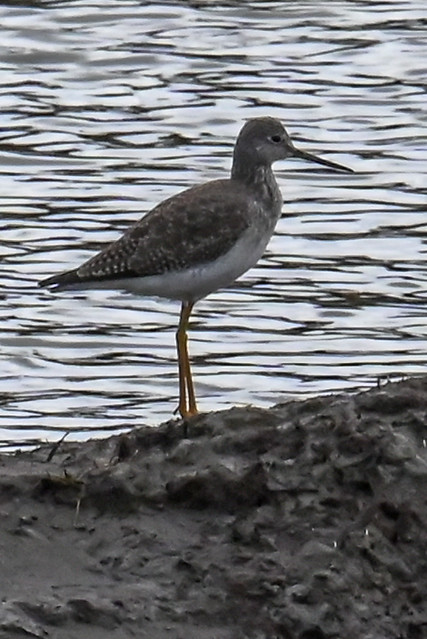 Lesser Yellowlegs at Leque Island. Do we agree?
Lesser Yellowlegs at Leque Island. Do we agree?
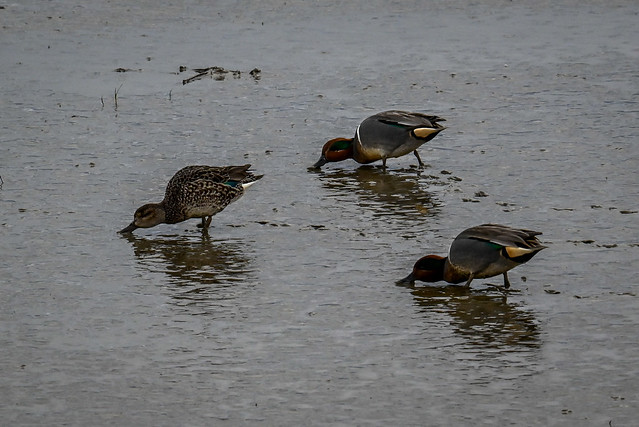 Green-winged Teals dabbling in the mudflats at Leque Island.
Green-winged Teals dabbling in the mudflats at Leque Island.
Here are the Day 3 checklists.
Day 4 — Crescent Lake Wildlife Management Area, Heirman Wildlife Preserve, Snohomish Wastewater Treatment Plant, and back to Edmonds
By Day 4, I did not have a Steller’s Jay on my count. As luck would have it, a lone Jay showed up in the morning at the home feeder. The day looked like rain would show up later. The plan was to start at Crescent Lake WMA out by Monroe and maybe spot some owls and woodpeckers. When I pulled up, there was a small flock of swans out in the fields. I needed a Tundra Swan for my count. And there among the Trumpeters was a handful of Tundra Swans with the unmistakable yellow cheek patch. As I wandered among the tall bigleaf maples, I played back some owl and woodpecker sounds on Merlin. No luck.
Next stop was Heirman Wildlife Preserve. There were a few ducks there and other birds that I had already clocked. So, I headed over to the Snohomish Wastewater Treatment Plant. Same deal, same ducks and birds. My next stop was to be Homeacres Road, fifth in the county species seen list for the GBBC. But the rain was coming down in earnest, so I decided to head for home.
The rain let up later in the day, so I decided to head back out to the Edmonds waterfront to see if I could add more species, especially a House Sparrow and a House Finch, my apparent nemesis birds for the GBBC. There is a hedgerow along the waterfront walkway where House Sparrows reliably hang out. Sure enough, I found them. Next I wandered over to the shrubby area by the ferry dock where House Finches hang out. There were a few there. So, I chalked up another two species to my count.
After chalking up my two nemesis birds, I headed over to the pier. Just maybe I would spot some Black Turnstones and Surfbirds on the breakwater. Nope, not there. As I was scanning the breakwater, I couple came by, super serious birders by the look — scopes mounted on tripods, outerwear by Arcteryx. I was wearing my tattered Woolrich mountain parka from the 1970s. It still smells like campfire. I didn’t have my camera with the big ass 150-500 mm lens. I just had my serviceable, I wouldn’t cry if I dropped them, Minolta binoculars. The gentleman asked me what there was to see. I told him of the possibility of seeing Black Turnstones and Surfbirds on the breakwater. They quickly moved on all the way out to the end of the pier where they set up their scopes. I wandered out that way and tried to pick up a conversation. “So, where you all from?” Without even looking up from her scope, she says “New York.” Not very friendly. As I walked away, I said “You know, all these gulls out here are hybrids.” Time to head home, have a beer, and bask in my success as the dark horse.
 Great Blue Heron at Crescent Lake Wildlife Management Area tries to stay hidden.
Great Blue Heron at Crescent Lake Wildlife Management Area tries to stay hidden.
Here are the Day 4 checklists.
Conclusion
Overall I placed fourth in Snohomish County and 58th in Washington State for the number of species counted over the four day span of the 2024 GBBC — 65 species in total. I feel pretty good about that, considering that I don’t think of myself as a serious birder. But I get better each year, though, learning the subtleties of bird identification. I had a blast doing this, especially being the dark horse among the top birders.
Here’s the top ten for Snohomish County:
You can explore all the data here: Great Backyard Bird Count — Final Results 2024
Closing
Have you participated in a Great Backyard Bird Count? What’s going on in your birding world? Where have you been and what have you seen lately?


